The Best Things To Do in Kraków
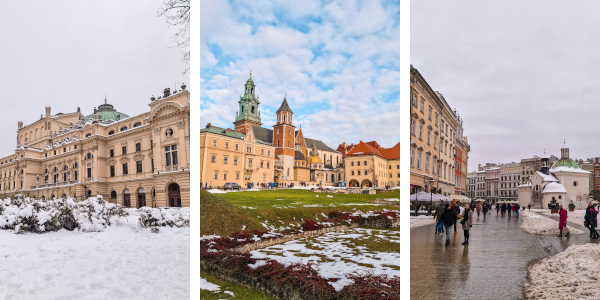
A Sightseeing Guide of Kraków
Kraków, the former capital of Poland, offers plenty of things to do with its rich history and beautiful architecture. From the narrow streets and medieval buildings in the old town, to the royal Wawel Castle and the nearby historical Kazimierz district, you won’t get bored in Kraków. When you’re done exploring the sightseeing spots, you can take a leisurely stroll along the Wisła River and enjoy the delicious Polish foods. In this blog post, we’re sharing the best things to do, ensuring that you can make the most out of your trip to Kraków.
Barbakan
The need for stronger fortifications led to the creation of the Barbakan in 1498, which served as an additional defensive structure for the city. In the past, the Gothic style Barbakan played a crucial role in the city’s defense system, protecting Kraków against potential invasions. The circular shape and the arrangement of turrets allowed defenders to cover all angles and repel attacks effectively. Today, the Barbakan is a well-preserved monument, offering visitors a glimpse into Kraków’s medieval defensive structures. Usually, you can explore the Barbakan, which now houses a museum showcasing historical weaponry and exhibits related to the city’s fortifications. Unfortunately, the Barbakan is temporarily closed at this moment. We couldn’t find any information on when the Barbakan would open its doors again for visitors. We still think it’s worth checking out this historical building that in our opinion kind of looks like a castle with its Gothic towers. We’d recommend checking this website for updated information on whether the Barbakan is open or not.
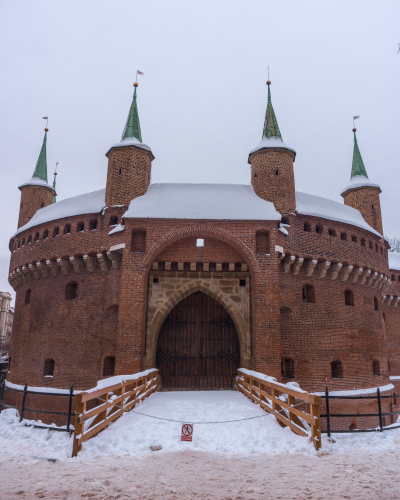
Barbakan
Former City Walls and Planty Park
Planty Park was established in the early 19th century, replacing the city’s medieval defensive walls and fortifications. The decision to dismantle the fortifications was made in the 19th century to provide a more open, recreational space for residents. The circular layout of the park mirrors the location of the former city walls. A network of walking paths crisscrosses Planty, offering a pleasant route for leisurely strolls. We actually loved wandering through the paths of Planty a lot. It provides a peaceful setting for relaxation, picnics, or simply unwinding amidst nature. There are Benches scattered throughout, so you can take a break and enjoy the green surroundings whenever you want. We were very lucky to see the park covered in a layer of snow. However, we can imagine that Planty is beautiful in any season.
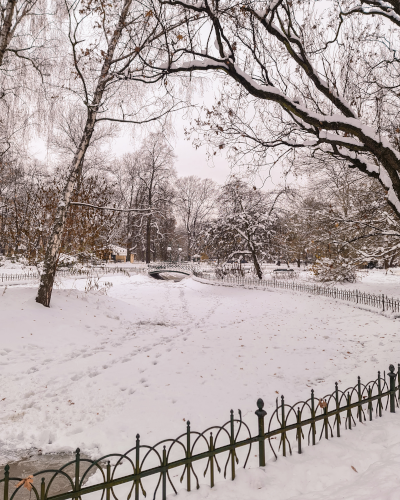
Planty
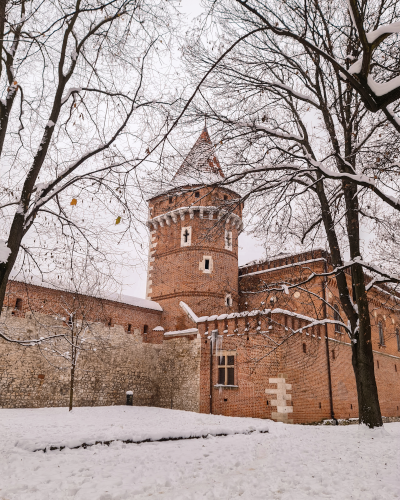
Last remaining part of the city walls
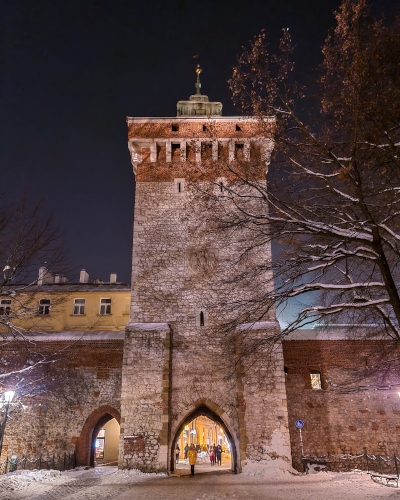
Saint Florian’s Gate, the old town’s gate
Juliusz Słowacki Theater
The Juliusz Słowacki Theater is located in Planty, near the Barbakan. Its construction ended in 1893, and it was designed in the eclectic style, modeled after the Palais Garnier in Paris. The theater is named after Juliusz Słowacki, one of Poland’s greatest poets. The Juliusz Słowacki Theater has played a significant role in Kraków’s cultural life for over a century. It has been a venue for a wide range of performances, including dramas, operas, and ballet. Unfortunately, the front facade was under renovation during our stay in Kraków, but the side facade of the building looked beautiful too. It might be fun to experience a performance in the theater someday too!
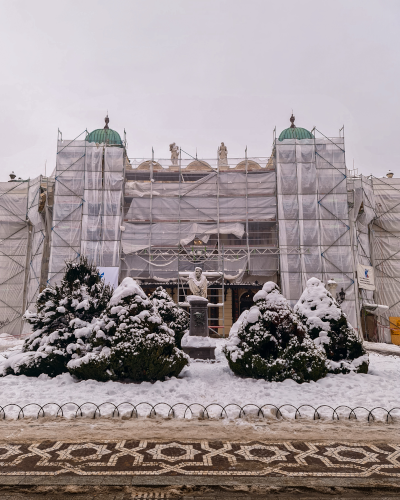
The front facade of the Juliusz Słowacki Theater was under renovation
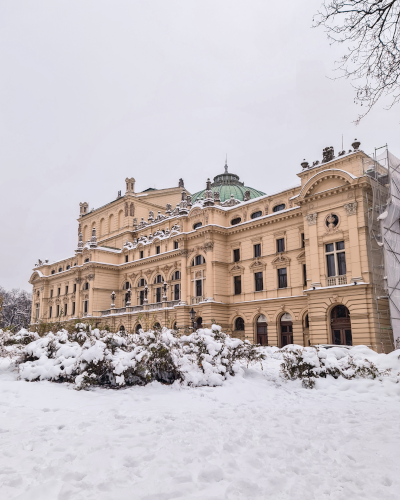
Side facade of the Juliusz Słowacki Theater
Rynek Główny
Rynek Główny, or the Main Market Square, is the central square of Kraków and one of the largest medieval town squares in Europe. Rynek Główny dates back to the 13th century, making it also one of the oldest market squares in Europe. Back in the day, the square served as a bustling center for trade and commerce. Merchants from various parts of Europe gathered here to exchange goods, and the square quickly became the economic heart of the city. Since 1978, Rynek Główny has been a UNESCO World Heritage Site. The square is surrounded by lots of cafés and restaurants, most of which have outdoor seating areas. Even in the winter months, the outdoor seating areas are fully encompassed by glass and provided with heaters, making it possible to sit outside when the temperatures are low. It’s a perfect place for people-watching and to enjoy a cup of coffee or a meal while surrounded by centuries of history.
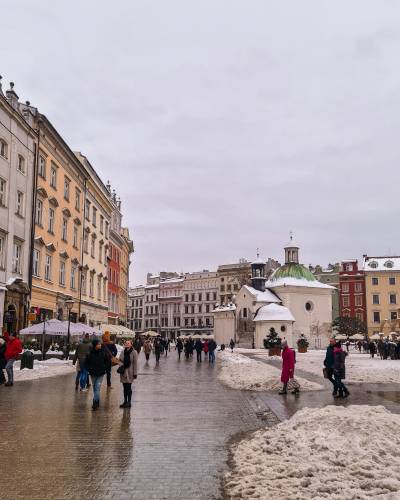
Rynek Główny
There are a few historically important buildings at Rynek Główny. The Sukiennice, or the Cloth Hall is the building in the center of Rynek Główny. During Kraków’s golden age in the 15th century, the Sukiennice was a major center of international trade. Textiles, spices, and other goods were traded within its walls, contributing to the economic prosperity of Kraków. The ground floor of the Sukiennice is characterized by beautiful arcades, providing shelter for market stalls and creating a covered marketplace. The open structure allowed for commerce while protecting traders from the elements. Currently, there are still shops in the stalls inside the building, selling traditional Polish arts and crafts, such as jewelry, textiles, and souvenirs. The upper floor of the Sukiennice has been converted into the Gallery of 19th-Century Polish Art, a branch of the National Museum in Kraków. The museum houses a collection of Polish paintings and sculptures from the 19th century.
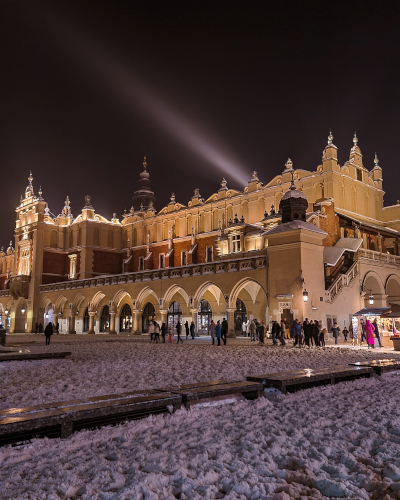
Sukiennice at night
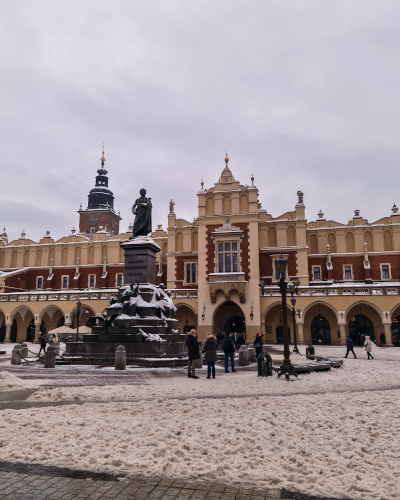
Sukiennice during the day
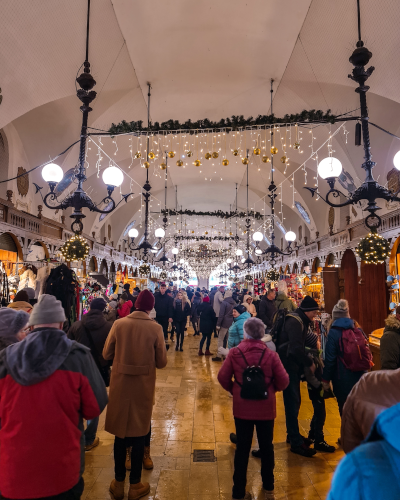
Inside the Sukiennice
You can’t miss the Bazylika Mariacka, or Saint Mary’s Basilica, when at Rynek Główny as it’s one of Kraków’s most recognizable buildings. The construction of Bazylika Mariacka spanned several centuries, with various elements added and modified over time. The main body of the church was constructed in the 14th century, while the towers and other elements were added in the following centuries. The basilica is renowned for its two towers of different heights. Legend has it that two brothers were hired to build the towers of Bazylika Mariacka. The elder sibling undertook the construction of the south tower, while the younger brother was assigned the north tower. Initially, the construction progressed smoothly, and both brothers worked at a similar pace. However, at some point it turned out that the south tower, built by the older brother, would be taller than the north tower. Driven by jealousy, the younger brother took the life of his elder sibling and commanded that the incomplete south tower be capped with a cupola. He then continued with the construction of his now elevated north tower as originally planned. The younger brother, however, was consumed by guilt. On the day of the towers’ consecration, he climbed to the top of his tower. While holding the knife he used to murder his brother, he publicly confessed the murder and jumped. Until this day, the murderer’s knife is showcased in the gate of the Sukiennice as a reminder to these tragic events.
The Bazylika Mariacka is open to visitors daily from 11:30 until 18:00. Check this website for more information.
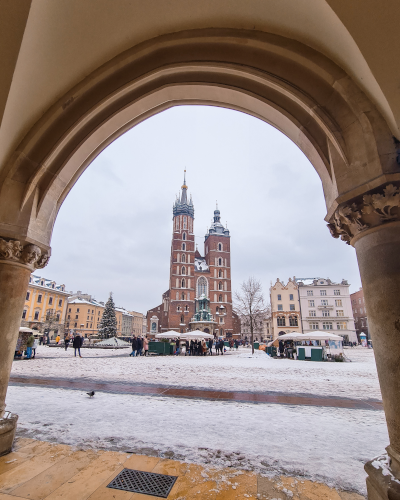
Bazylika Mariacka seen from the Sukiennice
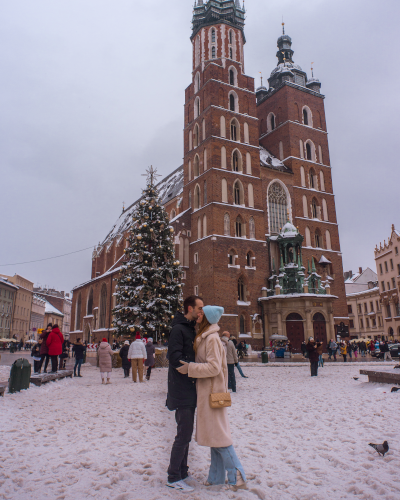
Bazylika Mariacka
Another building worth mentioning at Rynek Główny is the Town Hall Tower that stands next to the Sukiennice. The tower is the only remaining part of the old Kraków Town Hall, which was demolished in 1820. The 70 meters tall Gothic tower dates back to the 13th century. There used to be a prison in the cellars with a Medieval torture chamber. There’s an observation deck on the top floor of the tower which is usually open to visitors. Unfortunately, it was temporarily closed when we were in Kraków. We couldn’t find any information on when the observation deck of the Town Hall Tower would be open to visitors again. We’d recommend checking this website for updated information on whether the Town Hall Tower is open or not.
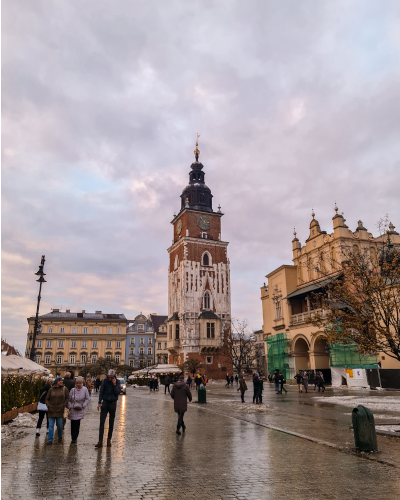
Town Hall Tower
Wawel Castle
Wawel Castle is a magnificent complex perched atop Wawel Hill that holds centuries of history and cultural significance. The first fortified structures on Wawel Hill date back to the 10th century. The early wooden and stone constructions served as a seat for Polish kings and rulers. Wawel Castle as it stands today was established on the orders of King Casimir III the Great in the 13th century and enlarged over the following centuries. It reflects various architectural styles, including Romanesque, Gothic, Renaissance, and Baroque. In the late 18th century, the castle fell into disrepair, but from the 20th century, extensive restoration work took place to restore Wawel Castle to its former glory. It’s a UNESCO World Heritage Site since 1978.
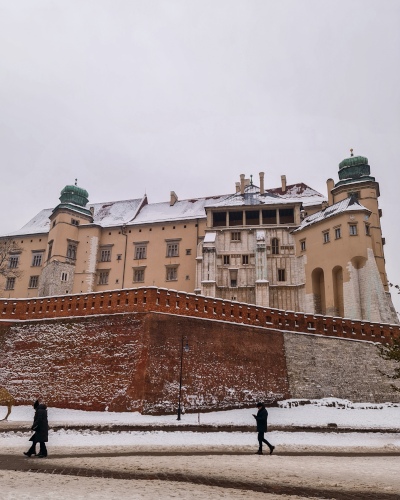
Wawel Castle
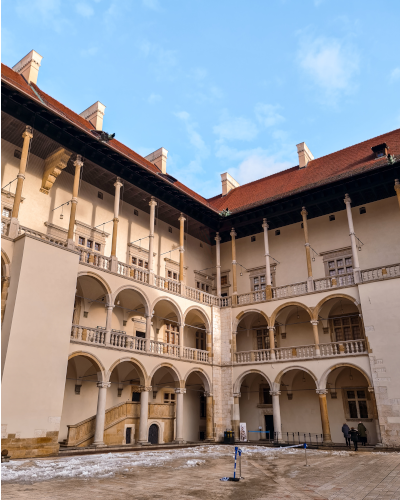
Courtyard of the Wawel Castle
Wawel Castle is now a museum complex, showcasing collections of art, historical artifacts, and royal chambers. When visiting Wawel Castle, you can choose from multiple exhibitions: the Crown Treasury, the Armoury, the State Rooms, Art of the Orient, the Lost Wawel and the Lapidarium. Besides these permanent exhibitions, there are also temporary exhibitions as well as visits with a tour guide. We visited the State Rooms and opted for an audio guide. It was very interesting to see the State Rooms which were used for senate sessions, royal audiences, wedding receptions and balls. Various paintings, furniture and tapestries are showcased in the rooms. We’d recommend getting an audio tour because otherwise you don’t really know what you’re looking at as there aren’t any information signs. If you want to visit any of the exhibitions in Wawel Castle, we’d recommend buying a ticket online in advance. We bought ours two days in advance, which is enough if you’re visiting on a weekday. If you’re visiting on the weekend we’d recommend getting a ticket a week ahead. Ticket prices vary depending on which exhibitions you want to visit. Click here to buy tickets online. It’s also possible to book a guided tour of Wawel Castle and the Cathedral, if that’s what you prefer.
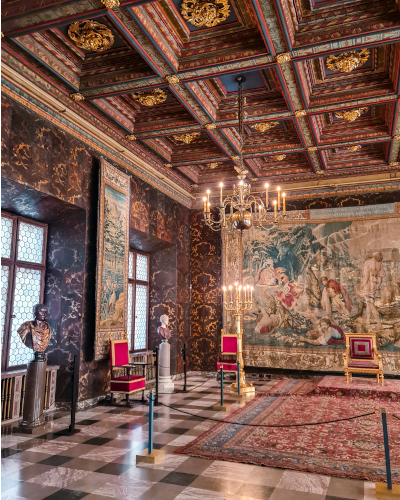
State Rooms in Wawel Castle
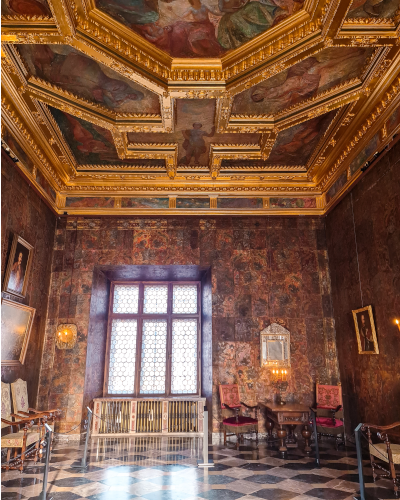
State Rooms in Wawel Castle
Opening hours of Wawel Castle
January - March: 09:30 until 17:00
April - June & September - December: 09:00 until 17:00
July & August: 09:00 until 18:00
Closed on Mondays, 18th until 22nd of March, 1st of april, 1st & 11th of November and 45th & 25th of December.
Check this website for the most recent opening hours.
Wawel Cathedral is considered part of the Wawel Castle complex. The cathedral dates back to the 14th century and it replaced a church that was destroyed in a fire. Over the centuries, the cathedral was expanded and the cathedral reflects various architectural styles, such as Romanesque, Gothic, Renaissance, Baroque, Neoclassical and Neogothic. You can visit the Wawel Cathedral too, the admission is 23 złoty (around €5,30) per person.
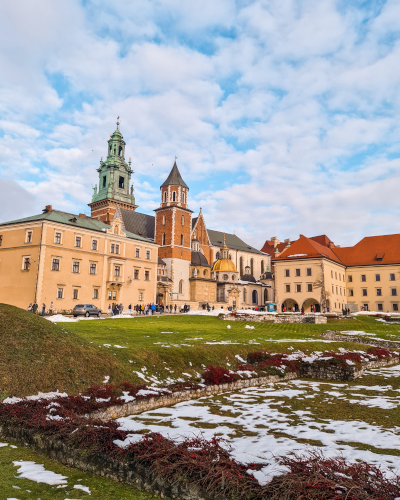
Wawel Cathedral
Opening hours of Wawel Cathedral
April - October
Monday until Saturday: from 09:00 until 17:00
Sunday: from 12:30 until 17:00
November - March
Monday until Saturday: from 09:00 until 16:00
Sunday: from 12:30 until 16:00
Closed on Good Friday, Holy Saturday, Easter Sunday, Christmas Eve (24th of December) and Christmas Day (25th of December). Check this website for the most recent opening hours.
Kazimierz
The town of Kazimierz was founded in 1335 by King Casimir III the Great, hence its name, which is derived from the king’s name. It was initially an independent town located just south of Kraków. In 1494, there was a conflict between Jewish and Christian merchants about the right to trade at the Kraków market. Therefore in 1495, the Jewish district was created in the northeastern part of Kazimierz where the Jewish people in Kraków had to live. Until 1800, the Jewish district was separated by fences and a stone wall. When Kazimierz became part of the city of Kraków, most of the Jewish people stayed in this district. However, because of World War II, which heavily affected the Jewish community in Poland, there aren’t many Jewish people living here anymore. Kazimierz is nowadays known for its lively streets filled with eclectic cafes, restaurants, and galleries. It has become a center for alternative culture, attracting artists, students, and those seeking a vibrant atmosphere. You can still find remnants of the Jewish history, such as synagogues, a Jewish cemetery and historical buildings. You can also a guided tour of Kazimierz to see all the highlights and learn more of the history of this neighborhood.
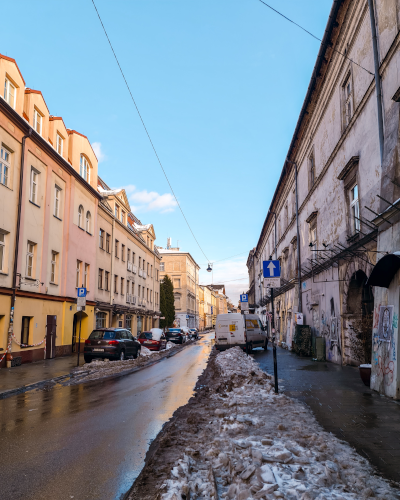
Kazimierz
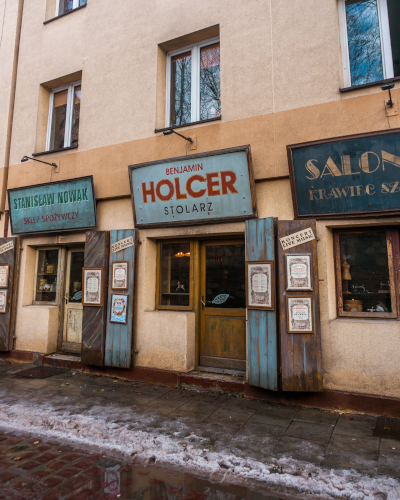
Holcer bar in Kazimierz
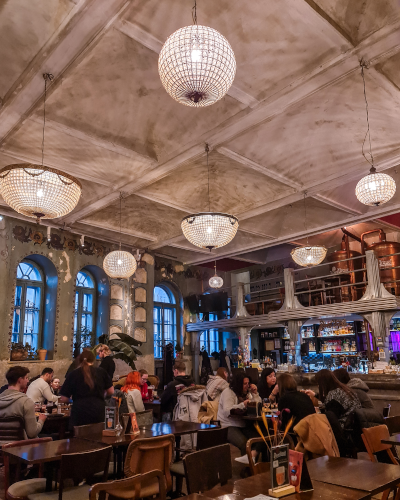
Hevre, a restaurant in an old synagogue
Saint Joseph’s Church and stroll along the Wisła River
Saint Joseph’s Church is an impressive cathedral built in the style of Gothic Revival. The cathedral was built between 1905 and 1909. You can find the cathedral just south of the Wisła River in the Podgórze district. It’s a beautiful cathedral to admire and well worth the 35-minute pleasant walk from the old town center. We also loved wandering around the Pódgorze district and along the Wisła River. We can recommend walking from the Podgórze district along the river towards Wawel Castle. It’s such a nice walk with beautiful views. If you’re walking on the south/west bank of the river, you can hop on to the ferris wheel too if you feel like it and enjoy the views of Kraków from above. It’s also possible to go on a boat tour on the Wisła River to admire the city from the water.
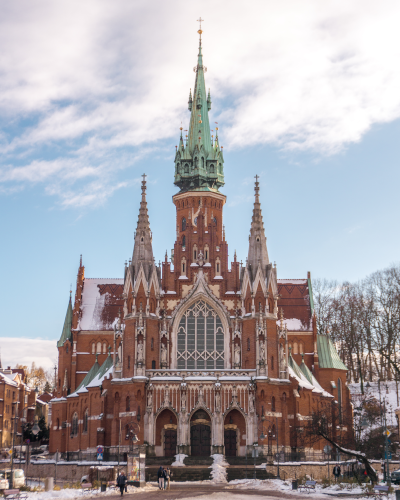
Saint Joseph’s Church
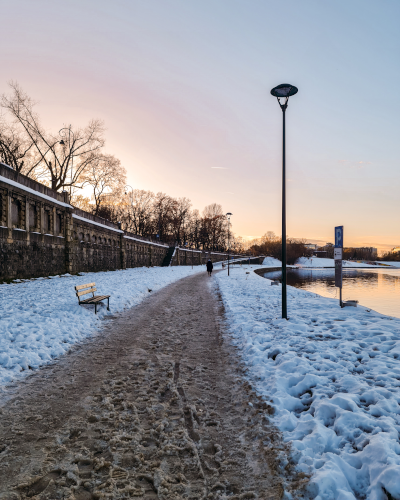
Stroll along the Wisła River
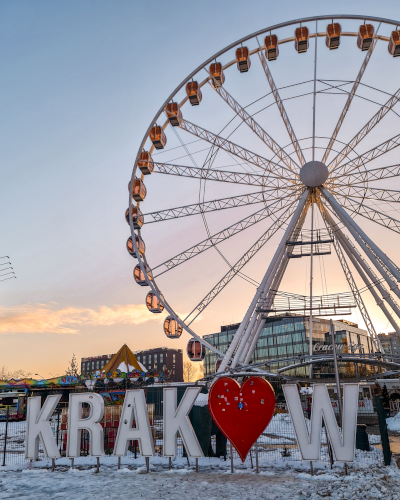
Kraków Eye
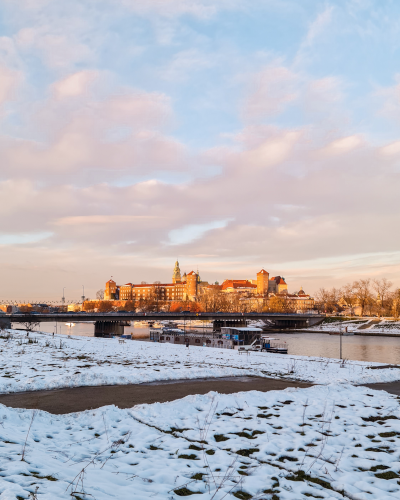
Wawel Castle from across the Wisła River
Eat traditional Polish food
It’s a must to indulge in the delicious Polish food when in Kraków. Our favorite foods we tried were pierogi, bigos and oscypek. Pierogi are perhaps the most iconic Polish dish. These dumplings are typically filled with a variety of ingredients such as potato and cheese, meat, and even fruit. Usually, they are boiled, but they can also be baked or fried and typically served with pickled onions. Bigos is known as hunter’s stew and is a hearty and flavorful dish made with sauerkraut, various meats (such as pork, beef, and sausage), mushrooms, and spices. We’d recommend looking for a place where they serve bigos in a bread bowl. It’s very nice with bread and it looks cool. Oscypek is a traditional Polish cheese made from salted sheep’s milk. This smoked cheese has a distinctive spindle shape and is best when it’s grilled. We can highly recommend having oscypek as a snack. We got ours at the Christmas Market, but we also saw a stand in the Galeria Krakowska mall near the entrance to the train station. Make sure to read our blog post in which we share 10 amazing places to eat and drink in Kraków for all our recommendations!
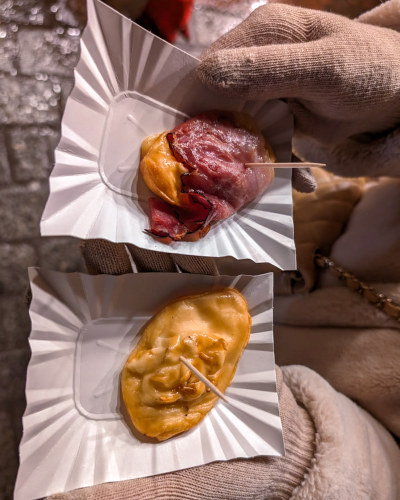
Oscypek
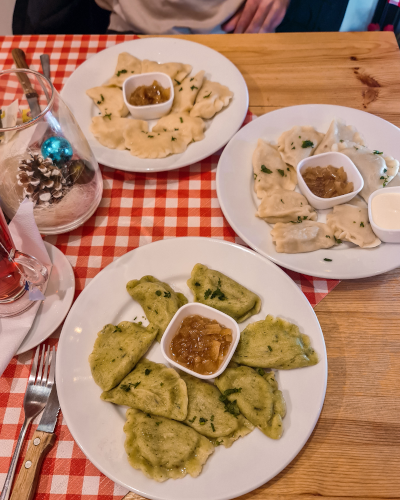
Pierogi
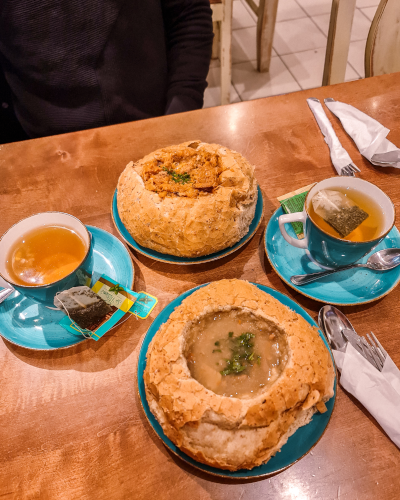
Bigos and mushroom soup in bread bowls
How long to stay in Kraków
We were in Kraków for three full days and we think it’s the perfect amount of time to take it slow or if you want to go on a day trip to, for instance, Auschwitz. Otherwise, two full days is plenty to see all Kraków’s highlights that we’ve listed before.
Unfortunately, we were too late with booking tickets for Auschwitz. If you want to go on an English tour in Auschwitz, we’d recommend to book tickets a month in advance as the availability is limited and tickets run out fast. Get Your Guide offers tickets for a guided tour in Auschwitz including transportation service from and to your hotel in Kraków for complete peace of mind.
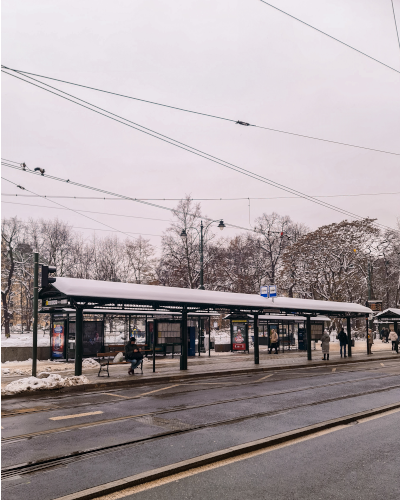
Even the tram stops in Kraków are picturesque
Best place to stay in Kraków
The optimal location for accommodation in Kraków would be within the former city walls. However, it’s worth noting that this area is not only the most centrally located but also the priciest and most bustling. If you choose to stay within the old city walls, it’s advisable to do some research. There are several nightclubs and bars that are open late into the night, even on weekdays. In case you’re staying near a nightclub, you might be disturbed in the middle of the night by people leaving the club. It’s something to keep in mind before booking a place in the old town.
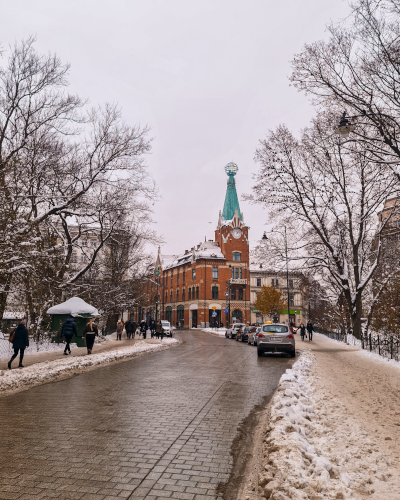
We decided to stay at Ibis Budget Stare Miasto, located just outside the historic city walls. The location turned out to be great as the hotel was right next to the main train station, offering direct train connections to the airport, and the Galeria Krakowska mall. It was only a 15-minute walk to Kraków’s main square Rynek Główny. We love Ibis hotels for their great price-quality ratio, and this one didn’t disappoint. The rooms are basic and small, but have everything you need for a short stay. There’s also a “normal” Ibis hotel next to the Budget one. As with many other Ibis hotels, there’s a car park available with reasonable rates, although we didn’t require it this time since we weren’t traveling by car. Click here to book a room at the Ibis Budget Kraków Stare Miasto or the “normal” Ibis Kraków Stare Miasto.
Click here for more accommodation options in Kraków.
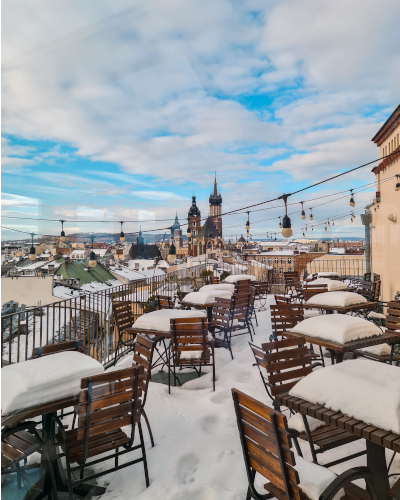
We hope you’ve enjoyed our guide to the best things to do in this beautiful city and that our blog post inspired you to visit Kraków. Have you been to Kraków or is it still on your travel bucket list? Let us know in the comments below!
Be sure to check out:
- our online prints store KIPAVISTA.com
- our daily life updates on Instagram
- our YouTube Channel
- our TikTok
More Poland
Visiting the Christmas Market in Kraków

